
Related
Topics
We host a roundtable discussion on covert police surveillance of demonstrations in New York City. Newly released video tape shows what the New York Times describes as “the robust presence of disguised officers” since the Republican National Convention in August 2004. We speak with the New York Police Department, I-Witness video, and The New York Times. [includes rush transcript]
Last Thursday, The New York Times published an article revealing that it had obtained videotapes showing the New York Police Department conducting surveillance by planting undercover officers to secretly infiltrate and monitor anti-war protests, bike rallies, and even a vigil for a dead cyclist. The footage the Times obtained showed officers holding protest signs, carrying flowers with mourners, riding their bicycles — and videotaping people at events.
The Times says that the footage shows at least ten undercover operatives taking part in seven public gatherings since the Republican National Convention in August 2004. In an editorial published the day after the story ran, The Times wrote, “it is a sad day when a police force generally known for its professionalism is caught using underhanded tactics to spy on and even distort political protests and mass rallies.”
This is the latest in a series of revelations about domestic spying that have come to light in the past few weeks. Last week NBC News revealed that the Pentagon has been monitoring peaceful anti-war protesters and the New York Times exposed how President Bush ordered the National Security Agency to eavesdrop on Americans without court-approved warrants. Also, newly released documents show that counterterrorism agents at the Federal Bureau of Investigation have been monitoring domestic organizations active in causes as diverse as peace, the environment, animal cruelty and poverty relief.
- Jim Dwyer, New York Times Metro reporter, author of the expose on covert police surveillance published December 22nd.
- Paul J. Browne, New York City Police Department’s Deputy Commissioner of Public Information.
- Eileen Clancy, forensic video analyst and member of I-Witness video, a project that assembled hundreds of videotapes shot during the RNC.
- Norman Siegel, longtime civil rights attorney. He is former head of the New York Civil Liberties Union.
Transcript
AMY GOODMAN: Our guests to talk about police surveillance of protest are Eileen Clancy of I-Witness Video; Jim Dwyer, New York Times reporter; Paul J. Browne joins us on the phone, Deputy Commissioner of Public Information for the New York Police Department; and Norman Siegel is with us in studio, long-time civil rights attorney, former head of the New York Civil Liberties Union. Jim Dwyer, let’s begin with you, your expose of last Thursday. What did you find?
JIM DWYER: We found that in the last 16 months, there was very robust presence by disguised police officers at a number of events, including anti-war protests, poor people’s march during the R.N.C. last year, and also at these mass bike rides, these group bike rides called Critical Mass. And until September 11th, the surveillance by the police of First Amendment-protected activities had been one of the most controlled and limited of all police powers, not only in New York City, but in big cities around the country, and also there were a lot of restrictions on the F.B.I.
After September 11, there were a lot of revisions made to those controls. They were done in each jurisdiction, but they all essentially moved in the same direction, which was to ease those restrictions. And New York Mayor Bloomberg and Commissioner Kelly both sought to ease those restrictions, saying that the threat of terrorism was so great that they were handcuffed in preventing future terrorists because of these rules.
AMY GOODMAN: Talk about the videotapes that you got.
JIM DWYER: The videotapes were from a variety of sources. They were all accumulated by I-Witness Video by Eileen Clancy’s sort of one-person operation, but with many tentacles, I would say, of information coming in from civilians, bystanders who were filming things, legal observers, activists who were filming stuff, as well as the Police Department’s own video, which was made public, in effect, during these trials of people arrested at these protests or at the bike rides, because the videotape would be turned over as part of the discovery process during the pretrial proceedings.
AMY GOODMAN: And these videotapes that you say document undercover police work, describe them.
JIM DWYER: Well, in some cases, they’re very explicit. You see people who are dressed up with buttons like “I’m a shameless agitator,” or, you know, buttons describing the mayor with a kind of a vulgarity, and people putting stickers on their bikes that say, “Bicycle riding is not a crime,” and so forth. And then they would go out and either circulate in the protest or they would ride in the bike ride. Sometimes they would be videotaping. Sometimes they would be holding slogans, you know, protest signs or signs indicating some kind of political belief.
And in one case — or in a couple of cases, what you see is what appear to be faked or sham arrests taking place of these individuals, and the purpose of those arrests is not entirely clear, but we know that in one instance, it had a very profound effect on a demonstration, when a man was arrested, who seemed to be standing on a sidewalk doing nothing more than holding a sign. He’s arrested by a police lieutenant, or a police lieutenant started the process of arresting him. The crowd — this is during the R.N.C. — objected to his arrest. People started shouting, “Let him go! Let him go!” And then, a confrontation developed between police officers in tactical riot gear and some of the people who were yelling and hollering about this arrest.
When you look at the videotape closely, it shows that the man actually did not have handcuffs on when he was led away. When they unzipped his backpack, it seemed that he had a radio of some sort in there, looked like a two-way radio, and he seemed to have a very cordial relationship, which was not typical at the moment of what was going on between the police and some of the demonstrators. So that was a pretty interesting piece of video.
And there was another piece where some officers — some people were arrested during one of the bike rides. And one of the officers — well, let me not jump ahead and say he’s an officer. One of the people who was arrested gets down on his knees, and he says to the arresting officer, “I’m on the job,” which is police lingo for meaning, “’I’m a cop, I’m a police officer, too.” And so, the uniformed officer responds by saying, “Hey, Louis,” typically a way of saying, “Hey, Lieutenant,” “Hey, Louis, he’s under.” So this man was led down the block and got back on his bike and away he rode. And two other people who were with him, a woman and a man, were put into the van with other people who were arrested, but about 25 minutes later, they were videotaped down in the Lower East Side at the scene of yet another arrest. So it was pretty clear that those people were not bike riders. It looks like the person who was arrested on 23rd Street holding the sign was not a protester. And that’s what the videotapes show.
AMY GOODMAN: Paul Browne, you’re Deputy Commissioner of Public Information. Your response to the New York Times reporter’s expose, Jim Dwyer?
PAUL J. BROWNE: Well, I think there’s a fundamental misunderstanding of what — it’s just wrong, flatly wrong, to say that after September 11th our activity in these areas picked up. That’s not what our reform of the Handschu Accord was all about. We went to court to have more leeway in conducting undercover investigations. Nothing described by Jim Dwyer was an undercover investigation. None of the officers were undercover officers. And it’s more than a semantical difference in the Police Department.
What he describes is activities typically done by anti-crime or plainclothes officers, beside the large crowds, whether it be New Year’s Eve, whether it be a political protest, to act or direct the actions of uniformed police officers when some sort of violence or criminal activity of any kind breaks out or lawbreaking, whether that would be just to arrest the bottle thrower in the middle of the crowd or direct his arrest or to identify the people blocking cross-town traffic during one of the mass bike rides in order to have them arrested. That’s what he described. That’s not undercover activity. It’s not undercover police officers. It’s not covered by Handschu. We did this kind of activity before and after September 11, and it’s virtually unchanged. And that’s the basic mistake in that reporting.
AMY GOODMAN: They’re not undercover, they’re what?
PAUL J. BROWNE: They’re anti-crime or plainclothes officers. It may be a semantical difference in Jim’s head, but it’s not in the Police Department’s.
JIM DWYER: Actually, if I —
AMY GOODMAN: Jim Dwyer.
PAUL J. BROWNE: And the other thing is when he uses the term, “Hey, Louis, he’s under,” for your listeners, “under” means under arrest, not undercover.
JIM DWYER: Right. Well, he was promptly released, and whether he was undercover or plainclothes or whatever, but —
PAUL J. BROWNE: Can I interrupt one second, Jim? You’re modulating in and out. I don’t know if there’s a way to improve what I am hearing.
JIM DWYER: Okay, I will try and talk louder. One of the things that happened when the Police Department went into the — when the city went in after 9/11 and sought different kinds of guidelines about the use of undercover officers was that it asked specifically that the distinction between undercover officers and plainclothes officers be eliminated from the guidelines that were put on them, and the court granted that request. It may still be that the function is, as Commissioner Browne says, entirely different, but that — not to get too semantical on anyone.
AMY GOODMAN: On this issue of Handschu, for people who are not familiar with this agreement, I’d like to bring in Norman Siegel, long-time civil rights attorney. Explain what the Handschu Agreement is in New York.
NORMAN SIEGEL: First, it’s Barbara Handschu and other political activists in the early 1970s, went to court on the premise that they were engaged in the First Amendment-protected activity and that the police were engaged in surveillance, spying on them, in violation of the First Amendment. In 1985, an agreement was entered into with the City of New York and the Police Department that, in effect, was a traditional check and balance on the Police Department, so with regard to video cameras at First Amendment activity, the police could turn on the video cameras when illegal activity was taking place or, in fact, someone was threatening or that there was imminent activity that was going to lead to illegal activity. There were also provisions in there with regard to when an undercover could engage in undercover, and it was basically a check.
There was a three-person commission that was set up that was supposedly independent of the Police Department that would review complaints by political activists with regard to surveillance, and they would put out an annual report. And, as Mr. Browne has stated, after 9/11, the Police Department and the City of New York went into the federal court and were able to lower the standard, and one of the concerns that I and other people in this civil rights community have is that we don’t think the traditional check, the accountability that we need in a democracy, over our law enforcement people is present. And with the lowering of the standard, I believe that this activity has increased and will increase in the months and years to come.
AMY GOODMAN: And that issue, Paul Browne of undercover versus plain clothes, that Jim Dwyer just raised.
PAUL J. BROWNE: Well, there’s two distinct functions here, what I’m talking about. Regardless of how he described them, that may not be important to your listeners, police officers who go to demonstrations in plain clothes are what we call anti-crime cops. They’re there for one purpose and that only. It has nothing to do with political surveillance. And that’s the misleading part of that story. They’re there to either intervene or to direct police intervention on some kind of lawbreaking that breaks out at that particular event.
AMY GOODMAN: Why do they get arrested?
PAUL J. BROWNE: They may get arrested or appear to be arrested just to keep functioning. I’m not certain that they did get arrested. I don’t know who these individuals are, but assuming if some of them are police officers, they may be led away, as if they’re under arrest, and then they continue to function.
AMY GOODMAN: We have to break. When we come back, we’ll continue this conversation with Paul Browne, Deputy Commissioner of New York Police Department, Deputy Commissioner of Public Information; Norman Siegel, long-time civil rights attorney; Jim Dwyer of The New York Times; and we’ll bring in Eileen Clancy of I-Witness Video who has videotape of so much of this undercover work.
[break]
AMY GOODMAN: We’re talking about police surveillance of political activity here in New York City. Our guests are Norman Siegel, long-time civil rights attorney, former head of the New York Civil Liberties Union; Jim Dwyer of The New York Times, did an expose on Thursday about police surveillance of protest over the last year; Paul Browne joins us on the phone, he is the Deputy Commissioner of Public Information for the New York Police Department; and Eileen Clancy is with us of I-Witness Video. Explain you what have documented in the videotapes that you have gathered, Eileen?
EILEEN CLANCY: The videotapes that are contained in The New York Times story show not merely the presence of police officers who are attending these events, because, of course, there are actually at some of these protests and demonstrations, there are dozens and even hundreds of police officers involved in policing these essentially always non-violent peaceful demonstrations. The videotapes really — these videotapes are looking at police officers who are going an extra step, dressing in clothing to appear to be demonstrators, putting on political slogans and stickers, in large parts in participating in the events in the case of the bicycle rides, bicycle riding with the bike riders, that type of thing, and maybe that have gone over the line, I think, in certain ways.
The situation with the woman that’s featured in the Times story, who appears to be an undercover police officer, it’s not merely that she was — she was participating in the event. She seemed to be calling in to police commanders where the locations of things, that type of a thing, and then apparently, she was arrested and then released very quickly and appeared at other events.
She also participated in a very tiny event, about 15 or 20 bicycle riders, who were having a memorial vigil, a silent memorial vigil for a 21-year-old woman that was run over by a garbage truck on Houston Street and Avenue A. And in remembrance of this woman, a few bicycle riders got together, joined together at Union Square, and they were followed by I don’t know how many police officers in unmarked vehicles, motorcycles, vans, and we don’t know what else. And this woman police officer participated in this small event. It is hard to imagine — I mean, these bicycle riders rode single-file in bicycle lanes, obeyed all the traffic laws. And as I said, they were followed by a large amount of police, considering their numbers, many more police than attended this little ride. Then they stopped at the scene where the woman had been killed, they had a memorial event, passed out flowers and so forth.
And this police officer videotaped the individuals involved in this event. This is absolutely repugnant. I mean, think what we have to do is we have to think about what is it the police are doing? Is there a legitimate purpose to this? What is this supposed to accomplish, beyond intimidation?
AMY GOODMAN: Paul Browne of the New York Police Department, your response.
PAUL J. BROWNE: Well, I think, starting to say that these events are always non-violent is just not the case. Beginning in 2002, when I returned the second time to the Police Department, New York had to cope with hosting the World Economic Forum. During that event, you had self-described anarchists, who would mask up, carry bottles of urine to throw at the police and bricks in their knapsacks, in one instance in an attempt to smash windows as the Plaza Hotel. We had anti-crime cops close to them. And when they attempted to move out, they were arrested.
During the R.N.C., there were others who wanted to stop delegate buses from — not only just peaceful protest, but others who wanted to, after the main march, wanted to effect a shutdown of the convention. There was an attempt to shut down Wall Street. Grandiose, I grant it, but attempted nonetheless, attempt to stop delegate buses from reaching the convention site. In those instances, anti-crime officers, plainclothes officers were involved in identifying where those individuals were so that uniformed officers could move in.
NORMAN SIEGEL: What’s the rationale for Critical Mass for violence? It’s been going on for ten years. Let me finish my question. For ten years, it’s going on.
PAUL J. BROWNE: You asked me what’s the rationale. I’ll tell you. Critical Mass was going along well, until a few months before the convention, when the riders — the ride was essentially hijacked by people who wanted to make more — who wanted to shut down the city in the process. They took over the FDR Drive, the West Side Highway. That’s when the police began devoting resources to it. And you just can’t decide that because you want to make a point about bike riding that you can shut down cross-town traffic at will.
NORMAN SIEGEL: In the last year, has there been that kind of activity?
PAUL J. BROWNE: Yes, there has. And we have made the arrests to stop it.
AMY GOODMAN: I want to go back to Still We Ride, the documentary about the Critical Mass movement. This is just a two-minute clip, and it begins with attorney Steve Hyman talking about what it takes for people not to be arrested. And it goes on to bring you the voices of police officers who are on the scene. This is Still We Ride, the documentary that was produced by Democracy Now! producer, Elizabeth Press, along with Andrew Lynn and Christopher Ryan.
STEVEN HYMAN, Civil Rights Attorney: There are real issues as to whether or not a permit is really just a device by the police to try to put an end to Critical Mass, and because once you have that device, that permit, they then set the ground rules and the terms, and when, where, how far it goes. So once that starts, then Critical Mass, as it is conceived and as the participants participate in it, will be at an end.
NORMAN SIEGEL: If you have a right to do something, you should not have to ask the government for permission to do that.
FATHER FRANK MORALES: It doesn’t take a rocket scientist to figure out that these guys sit around and figure, “Hey, we’ve got to stop this.” They had to stop the bandshell from being a place of free speech back some years ago, so they demolished it. They had to stop spontaneous marches from taking place, so they put permits on everything and put fee — you have to pay a fee to get a permit, and this, that and the other thing. They are trying through every means to limit our ability to dissent.
POLICE OFFICER: If these guys applied for a route and stuff like that, they could do whatever, but they don’t want to go that route. That’s the thing.
POLICE OFFICER: The peaceable people probably don’t come any more. They used to come with bicycles with seats on them, with their kids. You don’t want to bring your kids to the circus. This is ridiculous.
POLICE OFFICER: They’ve been riding for ten years, never a problem, you know. But at the R.N.C., they decided to use it as a tool to protest. Other people, not the Critical Mass people. The Critical Mass people have been riding for a long time, never a problem, rode peaceably, obeyed the rules, do what they gotta do. And then they were infiltrated by the ACLU and other groups, and they turned it into — now it’s become a political protest.
UNIDENTIFIED MAN: Do you think it could ever go back? Like, how could they go backwards and get the police off their back?
POLICE OFFICER: And now it’s become this. It’s become an anarchist group.
UNIDENTIFIED MAN: I had heard that they were still arresting people even if they stopped at the lights and stuff.
POLICE OFFICER: They can’t. What are they going to arrest them with? What are they going to charge them with?
UNIDENTIFIED MAN: The parade thing.
POLICE OFFICER: You have to break the law in order for a police officer to arrest you. That’s just the way it is.
AMY GOODMAN: That is an excerpt of Still We Ride. And those are the voices of police officers on the street, one saying, “What are they going to charge them with?” another saying it was a peaceful group until it was infiltrated by the ACLU, and now it’s become an anarchist group. Norman Siegel, your response.
NORMAN SIEGEL: Well, first of all, infiltrated by the ACLU, just not even close to reality. I think it shows that the police themselves, rank-and-file, are not sure that this is a very effective tactic. And also, with regard to the legitimate government interest of making sure that there isn’t violence at any of the events, I think when the Police Department has substantial evidence, reasonable basis for having people at a First Amendment activity, I have always felt that officers in uniform, which they do have, is the best deterrent to any kind of violent activity.
And the idea of putting people in non-uniform, plainclothes, as well as undercover, undermines what a democracy is supposed to be about. If I go to a First Amendment peaceful protest activity, the government should not have a file or a video database on my peaceful activity, and the part that also troubles me is that when they’re doing the video surveillance, what’s happening to that video? If, in fact, the video shows illegal activity, then you can keep it for the criminal case, Mr. Browne, but when, in fact, the video shows no illegal activity, are you erasing that material? Are you making sure that in a democracy, we don’t have the government having video databases on peaceful First Amendment activity?
AMY GOODMAN: Paul Browne of the New York Police Department.
PAUL J. BROWNE: We don’t keep political databases. We do preserve video for trials and for arrest situations and, as you well know, because some of them have been turned over for discovery purposes.
AMY GOODMAN: Let me just bring in Eileen Clancy for a minute.
PAUL J. BROWNE: Okay. I just want to make one quick point about the bike rides. We have also asked, repeatedly, to work out an arrangement with the organizers. Though they claim there is no organization, there is organization of the rides. We have asked to work with them to — so they could go forward in — and have cross-town traffic accommodated, some safety issues that we’re worried about accommodated. And we have been — the Police Department has been refused on that.
AMY GOODMAN: Eileen Clancy?
EILEEN CLANCY: Ever since the Tompkins Square Park riots have made it clear years ago that it was critically important for police officers to be identified, in case there were problems with misconduct, so they could be followed up on, you know, there had been for years and years a sense that pretty much, you know, you had police officers with numbers on their riot helmets and that sort of a thing in New York. And having so many police officers at these scenes now, you are not sure if they’re police officers. Sometimes they actually give commands to people or push people or move them around. People don’t know how to react, because they don’t know that they’re police officers. It creates this kind of confusion. And it’s really impossible in cases of misconduct to track down — to investigate these properly. C.C.R.B. has complained about this.
AMY GOODMAN: The Civilian Complaint Review Board.
NORMAN SIEGEL: The Civilian Complaint Review Board.
EILEEN CLANCY: Thank you, folks. But also, one of the important things, it’s not clear at all why police officers who are videotaping these political demonstrations are not identified. Under the original Handschu rules, they all had to be identified as police officers. And now, pretty much every time you see them, they do not have any police identification on them at all. They are sometimes doing this clandestinely from inside cars and vehicles. It’s a very confusing situation.
AMY GOODMAN: Commissioner Browne?
PAUL J. BROWNE: Well, they are identified. They wear — the officers who do videotaping are in —- are either in uniform or are wearing jackets that -—
EILEEN CLANCY: That’s absolutely not true, Commissioner Browne. I’m sorry, that’s just absolutely not true. It’s plainly visible. I mean, what comes to mind right away is a police officer wearing a black leather jacket and a Che Guevara t-shirt, that’s seen at many of these Critical Mass events, without any police identification whatsoever. This is typical.
PAUL J. BROWNE: Well, I can tell you, they wear wind jackets that say TARU on the back. It’s a technical —
AMY GOODMAN: Some do. I think it’s quite clear some do, some don’t. We have been showing videotape of people who are, whatever you call, undercover or plainclothes.
PAUL J. BROWNE: Well, I don’t know. You’re saying they’re undercover. I explained, I know it may not be an important difference to you, but it’s a very important difference —
AMY GOODMAN: I said undercover or plainclothes.
PAUL J. BROWNE: Undercover officers conduct investigations of groups. That’s why Handschu is so important. The anti-crime cops do not.

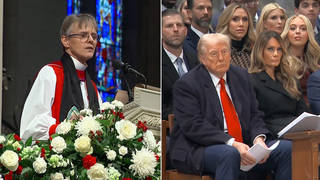
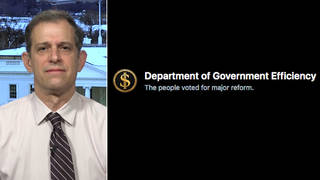
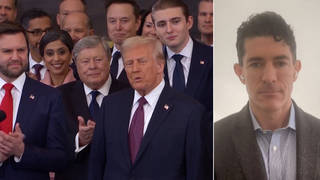
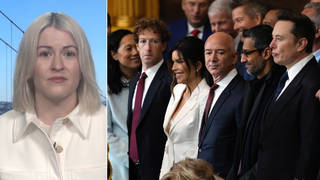
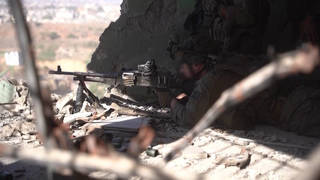




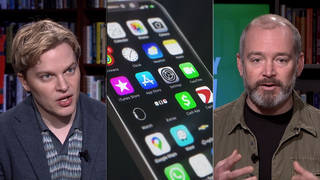
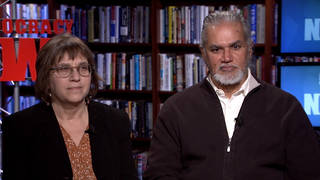
Media Options